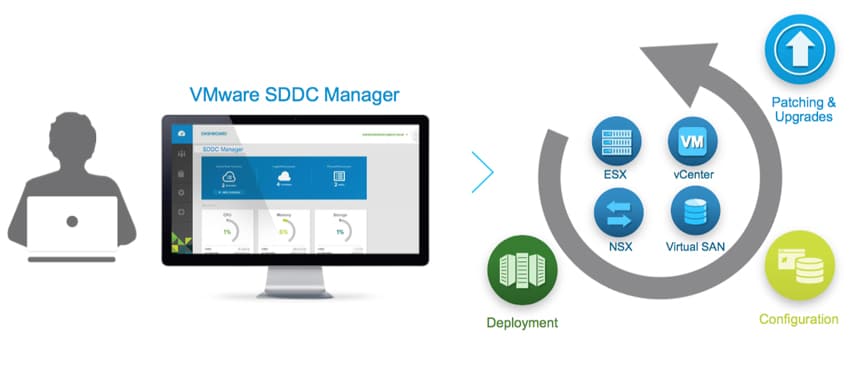Today at VMworld 2016 in Las Vegas, VMware introduced its new architecture that extends its hybrid cloud strategy, VMware Cross-Cloud Architecture. Along with this, VMware is also announcing new private and public cloud offerings helping customers to run, manage, connect, and secure their applications across clouds and devices in a common operating environment. These new offerings include VMware’s new unified software-defined data center (SDDC) platform, VMware Cloud Foundation, new DR offerings purpose built for vCloud Air Network partners, VMware vCloud Availability, and a new release of VMware vCloud Air Hybrid Cloud Manager.

VMware starts off with some fairly bold claims about its new Cross-Cloud Architecture. The company calls it the world’s most complete and capable hybrid cloud architecture. They go on to say the Cross-Cloud Architecture enables consistent deployment models, security policies, visibility, and governance for all applications, running on premises and off, regardless of the underlying cloud, hardware platform or hypervisor. The new architecture is delivered through VMware Cloud Foundation and a new set of cross-cloud services that are currently being developed by VMware.
The bedrock of his new Cross-Cloud Architecture is the VMware Cloud Foundation. Cloud Foundation is a unified SDDC platform that integrates VMware compute, storage and network virtualization. VMware states that this integration will make it easier for its customers to benefit from its SDDC offerings. This marks the first time VMware’s scalable hyper-converged software is combined with its network virtualization platform, VMware NSX. A key component of VMware Cloud Foundation is the VMware SDDC Manager. This manager helps customer use the entire VMware cloud software stack to build complete clouds, in what VMware claims, merely a few hours. SDDC Manager handles the tasks of installing, configuring, managing, and updating cloud infrastructure resulting in a 6-8 times in reduction while deploying cloud infrastructure and savings of 30-40% TCO. Cloud Foundation can run any traditional or cloud-native application regardless if they are in VMs or containers. And VMware Cloud Foundation integrates with existing VMware solutions.
VMware will also be offering Cloud Foundation as-a-service for hybrid cloud environments. The first VMware vCloud Air Network partner to take advantage of this as-a-service offering will be IBM, on its VMware on IBM Cloud offering in the third quarter. While this offering will be available on vCloud Air soon, VMware intends to have it available on additional public clouds in the future. Customers that would like to use Cloud Foundation on premises for private clouds can use VCE VxRack Systems or qualified VSAN Ready Nodes from Dell, HP, and QCT.
At VMworld there will be a tech preview of Cross-Cloud services, forthcoming SaaS offerings VMware is developing that they claim will enable visibility into cloud usage and costs, enhance consistent networking and security policies, and automate the deployment, management, and migration of applications and data across vSphere and non-vSphere private and public clouds. These new SaaS share a common operating environment for both public clouds and on-premises workloads, which, according to VMware, allows IT to protect data and applications and control costs while developers are free to innovate in the clouds they choose.
The new types of services that were previewed include:
- Discovery and Analytics: enabling discovery, onboarding, and governance of public cloud applications
- Compliance and Security: using micro-segmentation and monitoring to provide security and compliance for applications across clouds
- Deployment and Migration: providing developers the ability to work cross-cloud, and IT the ability to manage cross-cloud applications with security and compliance
VMware is also announcing innovations for VMware vCloud Air and the VMware vCloud Air Network service provider. VMware is offering new DR services for its vCloud Director with VMware vCloud Availability. Leveraging native vSphere replication capabilities, vCloud Availability’s DR services will be simple and cost-effective for vSphere environments. This new solution is designed expressly for VMware Service Providers and will help with further monetization of existing VMware cloud environments based on VMware vCloud Director’s multi-tenant cloud management capabilities.
And finally VMware is making enhancements to VMware vCloud Air, Hybrid Cloud Manager built around the simplification of application migration and improving performance of the connection between the two environments. Hybrid Cloud manager enables networks to stretch in the cloud but is said to show the performance as if they were local. VMware goes on to claim that Hybrid Cloud Manager can enable zero downtime, bi-directional migration of entire applications, as well as the migration of NSX security policies to vCloud Air Advanced Networking Services. Using an optimized network, customers can move VMs up to 20x faster while retaining the same security policies and controls available on-premises.




 Amazon
Amazon